OP-ED
From the wilds of Mana Pools to the urban fringes of Cape Town: Lessons learnt from living with baboons
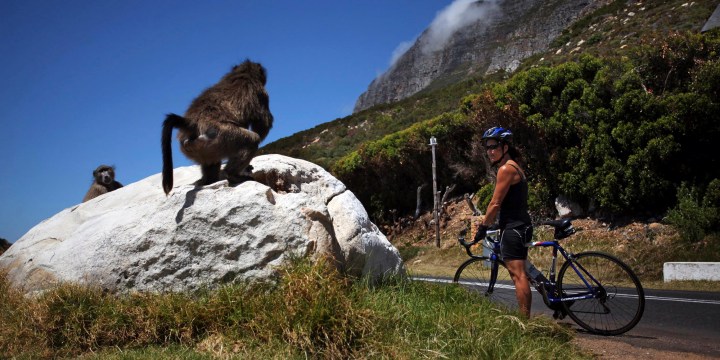
The problem with urban baboons is that the natural order of things gets blurred when the baboons get over-habituated and lose their natural fear of humans. The minute a dangerous animal learns that it does not need to fear humans and, in fact, humans can provide some very nice high-energy food as well, then the problems start. The natural reticence has gone, and there is a big reward just waiting to be taken.
Dr Phil Richardson is a behavioural ecologist and project manager at Human Wildlife Solutions. He is a research associate at the Institute for Communities and Wildlife in Africa (iCWild) at the University of Cape Town.
Almost all land-based animals fear humans. For good reason. For 300,000 years, anatomically modern humans, and for over a million years, our predecessors, have been hunting all sized mammals, birds and reptiles. Consequently, almost all mammals have an instinctive fear of humans because they have learnt that humans are generally more successful at hunting them than they have been at hunting or killing humans.
There are obvious exceptions to the rule. But even lions and elephants, which would obviously win most one-on-one battles, are still wary of humans and would generally rather avoid them than challenge them. Humans have achieved this wariness from the animal kingdom because they are smarter than other animals, and have learnt how to make weapons, use fire and communicate and collaborate in social groups to hunt and protect themselves.
At this stage in our evolutionary history, this is basically the status quo — “the natural order of things”, so to speak. One that most animal rights activists, often from cities, have forgotten. This status quo became very clear to my wife, Lynne, and me, when we spent six years living in tents, without any fences, in Mana Pools National Park in the Zambezi Valley of northern Zimbabwe. For the last four years of our time there, we were filming a wildlife documentary for National Geographic Television, called Walking with Lions. That is another story, but while we were there Nat Geo also made a film about us, called Living with Lions. Although we were indeed living in the middle of a pride of 20 lions’ territory, to us it was much more about living with baboons — because we really were.
Our tents were alongside a dry riverbed and pitched directly under three huge sausage trees, which normally produce tens of 1-2kg sausage-like fruits every year. The only reason we could live safely under these trees, without the risk of massive fruits falling on us, was because every night we were there (July to December), the baboons slept in the trees directly above us. The baboons ate all the flowers before they could ever produce any giant fruits. Every night we would go to sleep to the sounds of baboons squabbling and to the telltale sounds, and smells, of being a baboon lavatory. We were very careful though, never to let the baboons become our friends, or ever associate us as a source of food. Twenty years later this troop is still just as wild and wary of humans.
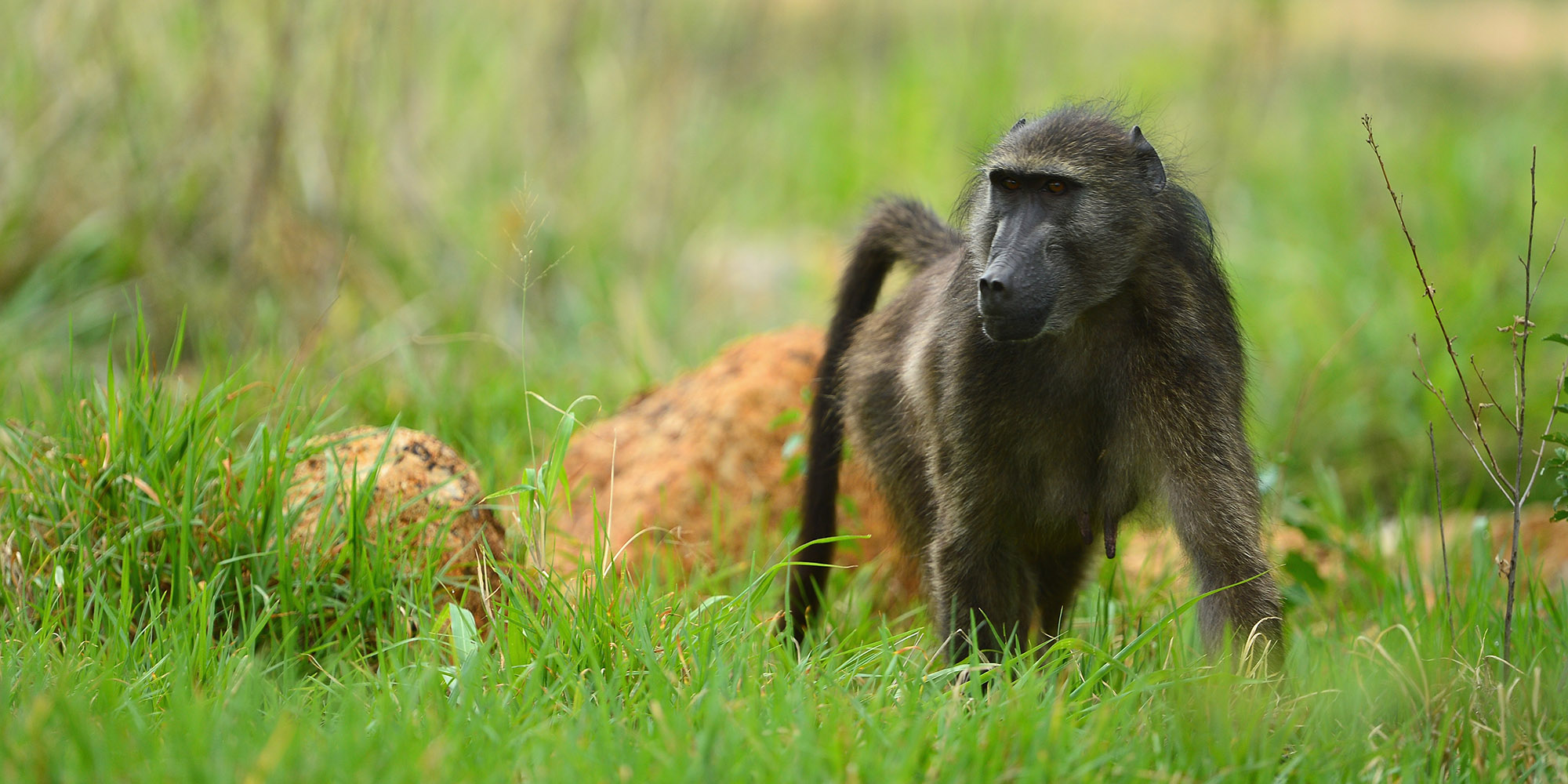
Baboons wander around on December 6, 2013 in Sun City, South Africa. (Photo: Stuart Franklin/Getty Images)
The baboons saw us every day as they came and went to their nightly roost. The juveniles often watched us from overhanging branches as we bathed our baby daughter in a basin. On the ground, however, they always gave us a wide berth of at least 10 metres and never allowed us to approach them. They were always wary of us, despite walking past us and around us having supper in the evenings.
So, to get back to the status quo, it was amazing that while we lived under a baboon roost, and had lions and elephants walking past our camp at the edge of a dry riverbed, there was always a great respect for each other. If we approached too close to film them, the baboons always sauntered away. The elephants and lions generally also walked away, but sometimes mock charged.
This, to me, is the crux of the matter. Why should an elephant or lion mock charge a human? Why not make it a full charge and get rid of the problem? Often while walking to a good viewing point or canvas hide, we would be stopped by a low, warning growl of a lion. We would scan around and spot them crouched under or behind a nearby bush. This was sufficient to alert us that we were invading their space. So, we would stop and take a wider berth. At other times they saw us too late, we were too close, so a mock charge was in order. We would stand our ground and sometimes shout and wave our arms, then we each went our own way again.
Clearly, the lions and elephants were signalling to us that they did not like us being too close and could flatten us if they wanted to. So why didn’t they? We were unarmed. With nothing more than pepper spray to protect us. I can only presume that evolutionary history had taught them that if they killed a human they would be in trouble: “the natural order of things”.
We were never charged by baboons in the wild. But in Cape Town one quite often hears of male baboons charging people. Sometimes they even push people over, and occasionally stand over them with teeth bared, but still they seem reluctant to bite. As if they know that would ultimately lead to much bigger trouble. The problem with urban baboons is that the natural order of things gets blurred when the baboons get over-habituated and lose their natural fear of humans.
The minute a dangerous animal learns that it does not need to fear humans and, in fact, humans can provide some very nice high-energy food as well, then the problems start. The natural reticence has gone, and there is a big reward just waiting to be taken. Once the wild animal learns that there is very little to lose and lots to gain, the game is over.
During the second half of the 20th century, when game lodges were becoming popular and many zoologists were starting to habituate wild animals in the field, people soon became very aware of the huge problems associated with rewarding habituated animals, or rewarding animals in order to habituate them for photographic or research purposes. Lions jumped on to the backs of bakkies that brought them food so that tourists could watch them feeding; chimpanzees and baboons became extremely aggressive to get their bananas. These sorts of practices very soon stopped because the lessons were well learnt, and the message passed on.
Despite wild animals’ natural fear of humans, it is often just a fine line that holds them back. Walking in the bush at night is a very different story from walking by day. Normally lions hunt by night and sleep by day. Humans are the exact opposite. They are scared of the dark, whereas lions thrive in the dark. They like to hunt under cover of darkness without any moonlight. It is easy to see how the balance could tip at night, and humans could indeed become prey.
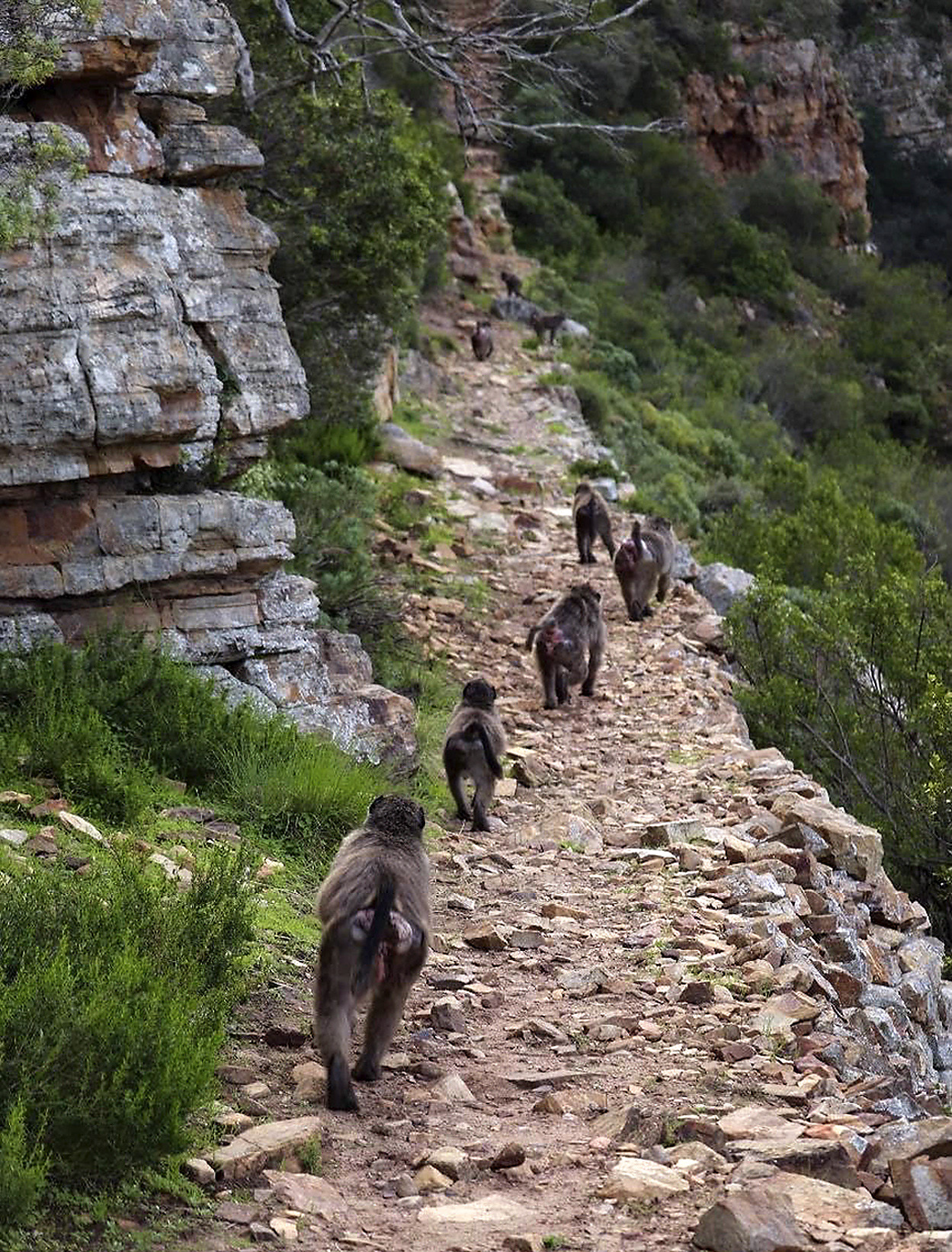
Waterfall troop on thier way to thier home range to roost for the night at Admirals waterfall.
(Photo: Di Ruthenberg)
A classic example of this is described in the famous book, The Man-eaters of Tsavo, written by JH Patterson in 1907. Similarly, during times of plenty, elephants generally avoid human habitation and crops, but during a drought the incentive to raid crops greatly increases as the balance of risks versus rewards changes as the drought progresses. And once they have learnt how easy the rewards are to obtain, the risks to humans and themselves escalate very quickly. Almost invariably, in all these events, the lions and elephants ultimately are killed for crossing the line.
Whether wild animals attempt to cross the line or not, primarily depends on two factors: economics (costs versus benefits), and knowledge. From the economics point of view, this is exactly how Professor Shirley Strum (University of California San Diego), a world-renowned primatologist, summarised the situation when she was invited to attend an international workshop organised to consider how to manage the Cape Town baboons in 2011. She said “I have tested and witnessed many control techniques in the past 40 years. They all point to the need to make the costs higher than the benefits for the baboons.”
Knowledge takes us back to habituation. It is easy to understand the temptation to habituate wild animals. Most field biologists and wildlife camera people have done it to a greater or lesser extent at some stage of their careers. It is an incredible experience to observe totally free-living wild animals from close range on foot. Opportunities like this allow one to take brilliant photographs and gain intimate knowledge of the habituated animals (presuming of course one’s presence does not change the animal’s behaviour).
However, habituation is a double-edged sword. Not only does the human gain intimate knowledge about the “wild” animal, but it also gains intimate knowledge about the humans. Furthermore, with increasing habituation, the humans become progressively less scary until, ultimately, it takes very little to tip the balance of “the natural order of things”.
Habituation frees animals from their instinctive fear of humans and allows them to take liberties they would never have dreamt of before. It is fake freedom, however, because “the natural order of things” returns as soon as the habituated animal encounters other humans not involved in the habituation process.
Habituation of wild animals therefore requires very serious ethical consideration before being undertaken by researchers or photographers. The key question is whether the habituated animals are ever likely to encounter “unhabituated” humans.
A classic example of habituation going wrong was the feeding of bananas to facilitate the habituation of chimpanzees and baboons at Gombe Stream National Park in Tanzania. These animals were fed bananas for years, to the point they were still “free-ranging” but became extremely aggressive. So aggressive, in fact, that the researcher involved felt compelled to raise her young child in a steel cage for his protection (Jane Goodall, 1971, In the Shadow of Man, London: William Collins Sons & Co).
This habituation process was strongly criticised by eminent primatologists Vernon Reynolds and Richard Wrangham in the mid-1970s. And for good reason (Reynolds, V, 1975. How wild are the Gombe chimpanzees?. Man, pp.123-125; and Wrangham, RW, 1974. Artificial feeding of chimpanzees and baboons in their natural habitat. Animal Behaviour, 22(1), pp.83-93).
As any African farmer knows, baboons are incredibly smart. Although they are not known to kill humans, there are cases in South Africa where baboons have injured people. For example, a four-year-old child’s belly was slashed open by a baboon while picnicking with his family at Kogel Bay between Gordon’s Bay and Rooi Els. And just a few months ago, a man was hospitalised after a baboon bit his shoulder.
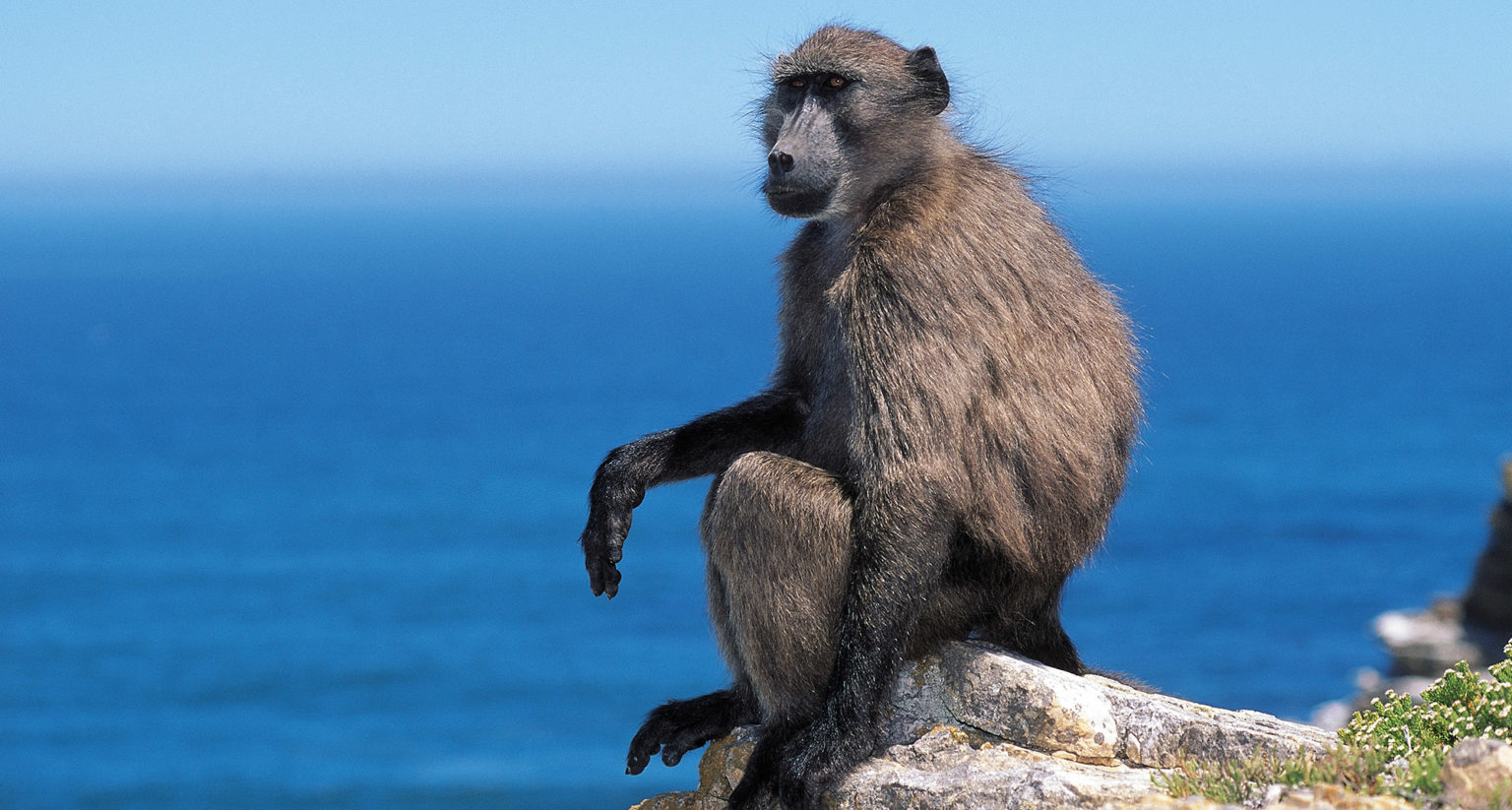
A baboon sits on a rock at the Cape Point Nature Reserve in Cape Town. (Photo: Gallo Images / BATELEUR PUBLISHING – MARK SKINNER)
Thankfully, such incidents are rare. What is much more evident is that baboons can cause great damage and trauma once they have learnt how easy and rewarding it is to eat human-derived food. An example of this is the behaviour of male baboons killing sheep in Namaqualand. When or where this behaviour started, is not known, but it is spreading slowly across this arid landscape as dispersing males take the behaviour learnt from their fathers and uncles to neighbouring troops. This habit is going from troop to troop and from farm to farm and having a devastating effect on many subsistence farmers in northern Namaqualand. Where or when this habit will stop, is also not known.
Having spent nearly 20 years either living with baboons in some of the deepest, wildest and most natural bush in Africa, or working with them on the edge of a huge African city (Cape Town), has taught us a great deal about these incredible animals.
The best part is the realisation that it is physically possible to live side by side with baboons, to respect each other, to tolerate each other, and also have almost no effect on each other as long as the humans are careful and respect the boundaries.
The worst part is the realisation of how easy it is for humans to totally ruin a whole troop of baboons within a very short space of time.
Feeding is an obvious recipe for disaster, although one can almost understand it if people are trying to be kind to the baboons. However, there can be no excuse these days for any deliberate prolonged habituation of a wild animal living within or just outside an urban area.
These animals will undoubtedly gain the false belief that humans can be trusted, and this trust will undoubtedly be betrayed, ultimately by those who habituated them. DM









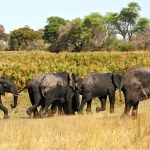










A timely article as Man and beast get ever closer in their everyday interactions. As the article underlines, boundaries must be rigidly kept and in particular, feeding is a definite no-no.
An excellent yet balanced article on this topic can be found on DM with the title “Cape Town’s baboon programme: Successful coexistence between wildlife and urban communities through trial and error”
Some valid points, particularly about not feeding baboons, boundaries, & giving them the false belief humans are to be trusted. The main intention of the article seems to be to try instil more fear, even citing Chimpanzee’s to bolster that motivation, but the people that already fear or hate baboons, don’t need further encouragement; & those that know & love them won’t be convinced either way. Then there’s the undecided…
Limiting interaction between humans & baboons makes sense. Without proper understanding of baboon behaviour, things can go wrong. But we’ve encroached on their habitat to such an extent, that human-baboon interaction is inevitable. If inevitable, why not improve relations by increasing understanding of baboons?Further, their natural food resources might be strained.
Remember, the Khoisan lived in harmony with the Chacma for centuries.
Today, certain communities peacefully co-exist with chacma baboons. People lock their bins & keep to themselves. Dogs, humans & baboons walk along the same street without issue. The occasional opportunist will grab a bag of shopping, but that’s met with with the appropriate response – NOT euthanasia, but water spray or catapult. There’s consensus around this approach & so far its working.
The crux of the matter is this: By killing the smartest of the baboons, the HWS is actually going against the ‘natural order of things’ because in nature, these individuals would benefit the species in the long term.